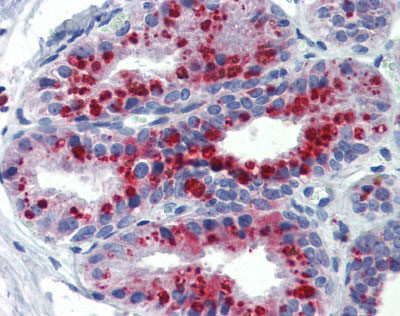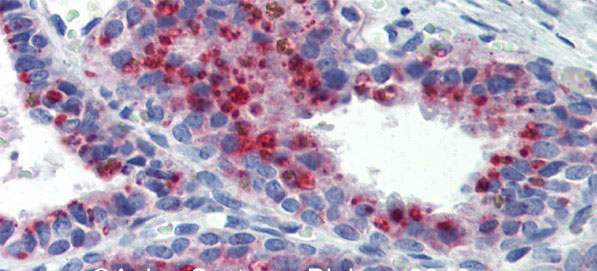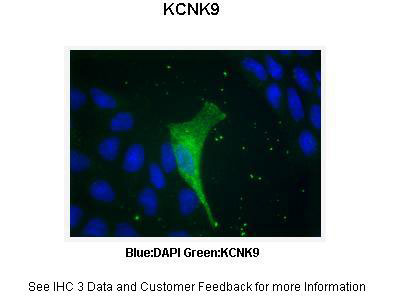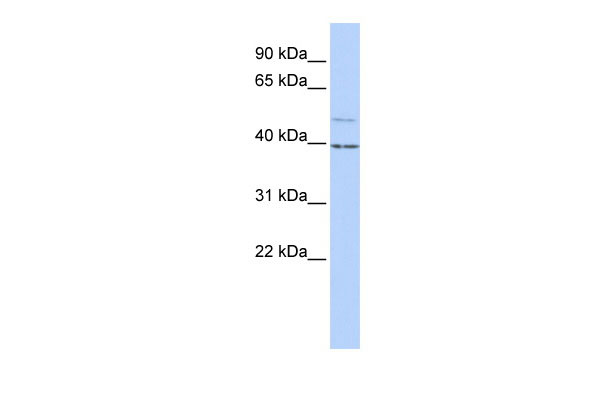KCNK9 antibody - N-terminal region
Rabbit Polyclonal Antibody
- 产品详情
- 实验流程
Application
| WB, IHC |
|---|---|
| Primary Accession | Q9NPC2 |
| Other Accession | NM_016601, NP_057685 |
| Reactivity | Human, Mouse, Rat, Rabbit, Guinea Pig, Horse, Bovine |
| Predicted | Human, Mouse, Rat, Chicken, Guinea Pig |
| Host | Rabbit |
| Clonality | Polyclonal |
| Calculated MW | 42264 Da |
| Gene ID | 51305 |
|---|---|
| Alias Symbol | K2p9.1, KT3.2, MGC138268, MGC138270, TASK-3, TASK3 |
| Other Names | Potassium channel subfamily K member 9, Acid-sensitive potassium channel protein TASK-3, TWIK-related acid-sensitive K(+) channel 3, Two pore potassium channel KT3.2, Two pore K(+) channel KT3.2, KCNK9, TASK3 |
| Format | Liquid. Purified antibody supplied in 1x PBS buffer with 0.09% (w/v) sodium azide and 2% sucrose. |
| Reconstitution & Storage | Add 50 ul of distilled water. Final anti-KCNK9 antibody concentration is 1 mg/ml in PBS buffer with 2% sucrose. For longer periods of storage, store at 20°C. Avoid repeat freeze-thaw cycles. |
| Precautions | KCNK9 antibody - N-terminal region is for research use only and not for use in diagnostic or therapeutic procedures. |
| Name | KCNK9 {ECO:0000303|PubMed:18678320, ECO:0000312|HGNC:HGNC:6283} |
|---|---|
| Function | K(+) channel that conducts voltage-dependent outward rectifying currents upon membrane depolarization. Voltage sensing is coupled to K(+) electrochemical gradient in an 'ion flux gating' mode where outward but not inward ion flow opens the gate (PubMed:11042359, PubMed:11431495, PubMed:26919430, PubMed:38630723). Changes ion selectivity and becomes permeable to Na(+) ions in response to extracellular acidification. Protonation of the pH sensor His-98 stabilizes C-type inactivation conformation likely converting the channel from outward K(+)-conducting, to inward Na(+)-conducting to nonconductive state (PubMed:22948150, PubMed:38630723). Homo- and heterodimerizes to form functional channels with distinct regulatory and gating properties (By similarity) (PubMed:23169818, PubMed:38630723). Allows K(+) currents with fast-gating kinetics important for the repolarization and hyperpolarization phases of action potentials (By similarity). In granule neurons, hyperpolarizes the resting membrane potential to limit intrinsic neuronal excitability, but once the action potential threshold is reached, supports high- frequency action potential firing and increased neuronal excitability. Homomeric and/or heteromeric KCNK3:KCNK9 channels operate in cerebellar granule cells, whereas heteromeric KCNK1:KCNK9 enables currents in hippocampal dentate gyrus granule neurons (By similarity). Dispensable for central chemosensory respiration i.e. breathing controlled by brainstem CO2/pH, it rather conducts pH-sensitive currents and controls the firing rate of serotonergic raphe neurons involved in potentiation of the respiratory chemoreflex (By similarity). In retinal ganglion cells, mediates outward currents that regulate action potentials in response to acidification of the synaptic cleft. Involved in transmission of image-forming and nonimage-forming visual information in the retina (By similarity). In adrenal gland, contributes to the maintenance of a hyperpolarized resting membrane potential of aldosterone-producing cells at zona glomerulosa and limits aldosterone release as part of a regulatory mechanism that controls arterial blood pressure and electrolyte homeostasis (By similarity). |
| Cellular Location | Cell membrane; Multi-pass membrane protein. Mitochondrion inner membrane {ECO:0000250|UniProtKB:Q3LS21}; Multi-pass membrane protein. Cell projection, dendrite {ECO:0000250|UniProtKB:Q3LS21}. Note=Colocalizes with MAP2 in the soma and proximal dendrites of dentate gyrus granule cells {ECO:0000250|UniProtKB:Q3LS21} |
| Tissue Location | Mainly found in the cerebellum. Also found in adrenal gland, kidney and lung. |
Research Areas
For Research Use Only. Not For Use In Diagnostic Procedures.
Application Protocols
Provided below are standard protocols that you may find useful for product applications.
REFERENCES
Rusznak,Z., (2008) Virchows Arch. 452 (4), 415-426
终于等到您。ABCEPTA(百远生物)抗体产品。
点击下方“我要评价 ”按钮提交您的反馈信息,您的反馈和评价是我们最宝贵的财富之一,
我们将在1-3个工作日内处理您的反馈信息。
如有疑问,联系:0512-88856768 tech-china@abcepta.com.























 癌症的基本特征包括细胞增殖、血管生成、迁移、凋亡逃避机制和细胞永生等。找到癌症发生过程中这些通路的关键标记物和对应的抗体用于检测至关重要。
癌症的基本特征包括细胞增殖、血管生成、迁移、凋亡逃避机制和细胞永生等。找到癌症发生过程中这些通路的关键标记物和对应的抗体用于检测至关重要。 为您推荐一个泛素化位点预测神器——泛素化分析工具,可以为您的蛋白的泛素化位点作出预测和评分。
为您推荐一个泛素化位点预测神器——泛素化分析工具,可以为您的蛋白的泛素化位点作出预测和评分。 细胞自噬受体图形绘图工具为你的蛋白的细胞受体结合位点作出预测和评分,识别结合到自噬通路中的蛋白是非常重要的,便于让我们理解自噬在正常生理、病理过程中的作用,如发育、细胞分化、神经退化性疾病、压力条件下、感染和癌症。
细胞自噬受体图形绘图工具为你的蛋白的细胞受体结合位点作出预测和评分,识别结合到自噬通路中的蛋白是非常重要的,便于让我们理解自噬在正常生理、病理过程中的作用,如发育、细胞分化、神经退化性疾病、压力条件下、感染和癌症。









